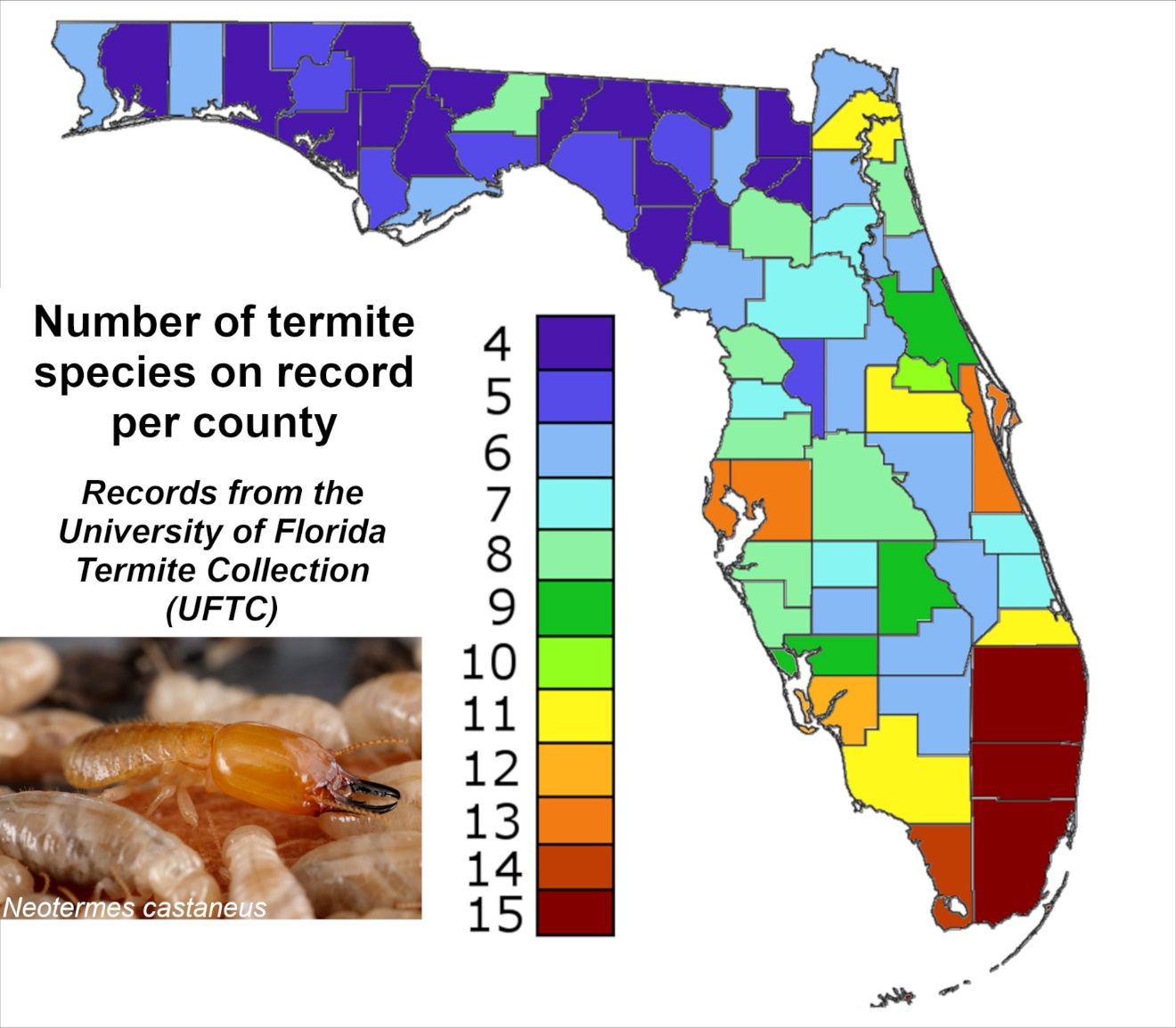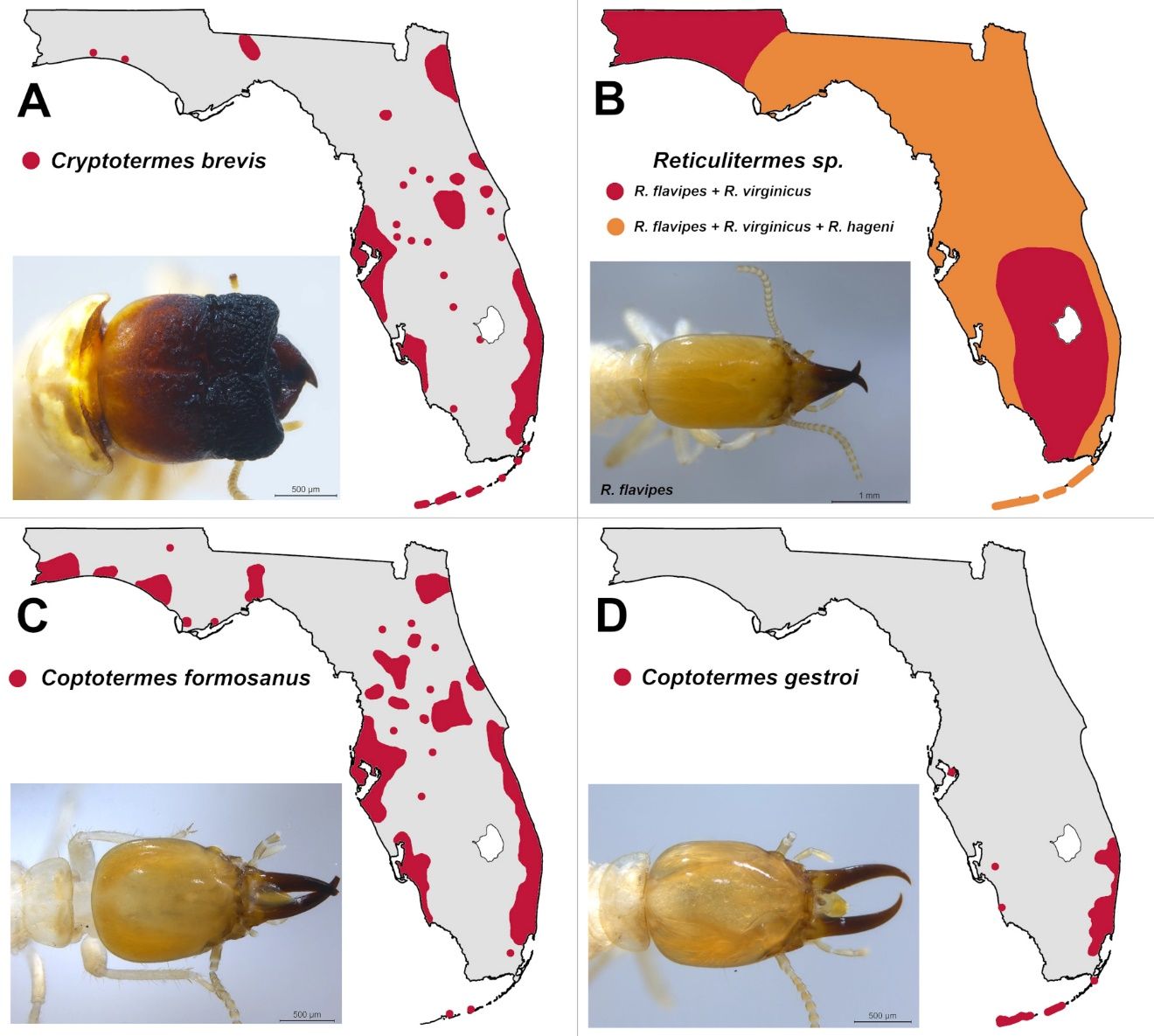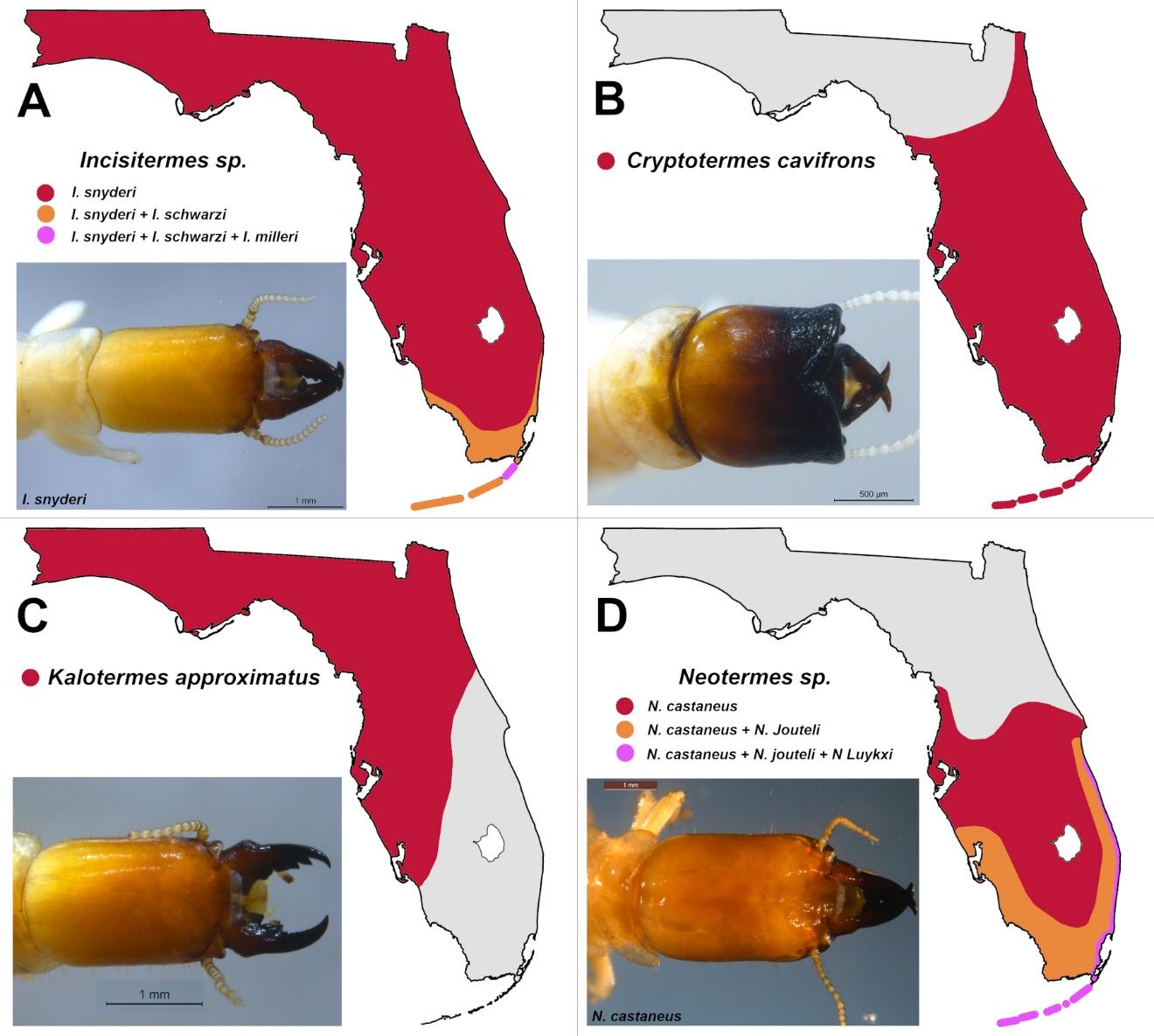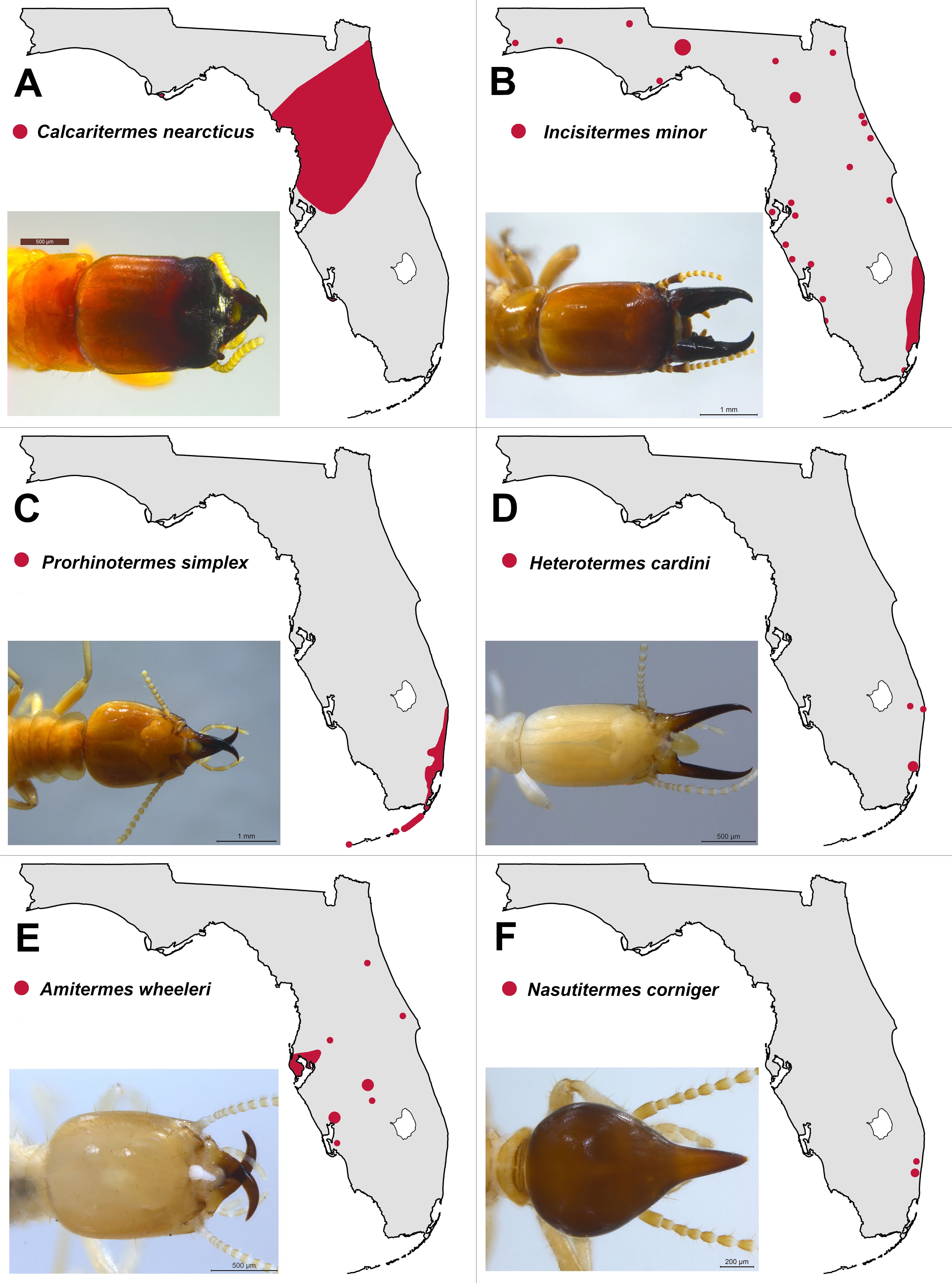Abstract
There are 20 termite species established in Florida. However, not all species have a pest status, and some invasive termite species affect only the parts of Florida where they are currently established. Through the accumulation of more than 6,500 termite samples over the years, this publication highlights where each termite species is known to be established, so that Florida residents, pest control companies and UF/IFAS Extension agents can be informed about what is the termite risk at any given location within the state. This publication is a companion resource to the online termite distribution map available at https://flrec.ifas.ufl.edu/termites-in-florida/termite-distribution/. It is critical that a termite sample be identified to species prior to seeking treatment options. Therefore, the UF/IFAS termite research team provides identification services to issue guidance. In addition, because some invasive species continue to spread, there is an ongoing need for reporting termite samples so that various communities across Florida have access to up-to-date knowledge of what termite species have been reported in their respective areas.
Introduction
With its unique geographic location within the mainland United States, Florida displays a relatively high native biological diversity but also displays a high number of established invasive species. This general rule also applies to termites. Florida, with 20 established termite species, remains the state with the highest termite diversity in mainland United States. Among these 20 termite species, six of them are invasive, including major structural pest species. In addition, several other invasive termite species (listed at the end of this publication) were intercepted at ports of entry or a single infested location was found but the species was not subsequently reported.
Not all termites impact Floridians in the same way (Table 1) because the potential termite pressure to human structures varies greatly depending on local climate and on termite species. Some species are located only in the tropical parts of the state, while others are only found in central or northern Florida. Many species are only found in dead branches of trees, while others are found exclusively in structures. Some species are pests, while other species, although present in the environment, have few or no negative impacts on people. Therefore, when termites are found, it is very important to first confirm the species identification before taking action. Depending on the species, no action may be necessary, a simple removal of infested material could be the solution, structural fumigation may be the only recourse, bait could be recommended, or a liquid termiticide treatment in surrounding soils may be necessary.
Treatments are target-specific and are often mutually exclusive. Thus, to limit the misuse of pesticides, proper termite species identification is the first step to take. However, termite identification often requires trained eyes. Termite colonies are composed of distinct castes (soldier caste, worker caste, reproductive caste: winged or wingless), all of which have their own distinct characters that are often difficult to see. Because termites are small, identification usually requires a microscope or high-resolution camera, even for an experienced termite identifier.
Table 1. List of established termite species and their status in Florida.
This publication provides the currently estimated distribution of all 20 termite species occurring in Florida (Table 1). The distribution ranges of all termite species were determined by using the cumulative sampling effort performed over the past four decades, which accumulated more than 6,500 termite samples obtained from around the state of Florida. Samples were obtained either by biological surveys, by pest control providers, by private residents, or by UF/IFAS Extension offices. All samples were identified to species by a member of the “UF termite ID team” or the “UF Insect ID Lab” and placed in the University of Florida Termite Collection (UFTC) located at the Ft Lauderdale Research and Education Center (FLREC). In 2016, the collection location of all termite samples became publicly accessible via the use of an interactive online map that is regularly updated at https://flrec.ifas.ufl.edu/termites-in-florida/termite-distribution/. Additional images of termites and termite damage in Florida are available at https://www.rudolfscheffrahn.com/, and the complete UFTC data are available at https://www.termitediversity.org/.
Thanks to this sampling effort and its resulting distribution map, Floridians can now know what termite species may be present within their area. This knowledge will help them be proactive to prevent or limit potential termite damage. In addition, by continuing to provide new termite samples from across Florida, many pest control providers and private Florida residents are contributing invaluable samples such as first county records for any given invasive termite species, or samples that indicate a change in the boundaries of the known distribution of various termite species. To support this sampling effort or to obtain a termite identification, see the instructions at the end of this publication on how to provide samples through the UF termite identification services.
Termite Diversity in Florida by County
In Florida, termite species diversity generally follows a latitudinal gradient, as observed from county records (Figure 1). However, these records are subject to interpretation. First, the relative human population density directly impacts sampling efforts. Second, urban locations, especially in coastal areas, are prone to the introduction of invasive species. Therefore, the gradient observed is highly altered by discrepancies emerging from sampling bias, and by the inherent biology of some invasive termite species that are strongly associated with human activity, which increases their chance of establishing—and being detected—in highly populated areas. These county records are therefore imperfect, as sampling efforts would need to improve in many locations in order to obtain a more complete distribution. Despite these sampling shortfalls, the current distribution of most termite species can be estimated from current data, as described below.

Credit: Rudolf Scheffrahn, UFTC
Distribution of the Most Commonly Reported Termite Species
The pest status of termite species (Table 1) portends that those of greatest pest status are most likely to be reported by the public at large. Approximately 65% of all termite samples on record belong to the handful of major termite pest species in Florida (Figure 2).

Credit: Rudolf Scheffrahn, UFTC
Cryptotermes brevis
The West Indian drywood termite, Cryptotermes brevis (https://edis.ifas.ufl.edu/publication/IN236), is an invasive termite pest species that is exclusively associated with structures because of its relatively low moisture requirements to establish colonies. This species has spread to many cities (Figure 2A) throughout the state as whole colonies can be transported by moving infested wood. The relative density of C. brevis populations and associated dispersal flights of alates within locations may reflect on how long this species has been established in the area.
Reticulitermes species
Native subterranean termites (https://edis.ifas.ufl.edu/publication/IN369) represent a complex of three primary Reticulitermes species (Figure 2B). Their historical distribution throughout the Eastern United States makes them relatively ubiquitous within their range. In Florida, both R. flavipes and R. virginicus can be found statewide. In comparison, R. hageni has not been found infesting structures as often as the two other Reticulitermes species and has a spottier distribution within the state.
Coptotermes formosanus
The Formosan subterranean termite, Coptotermes formosanus (https://edis.ifas.ufl.edu/publication/IN278), is an invasive termite species distributed throughout most major cities in the southeastern states. In Florida, it is primarily found in coastal cities but is also now found in some large cities in central and northern Florida (Figure 2C) as it continues to spread steadily since its first detection in Florida in the early 1980s. Colonies of this species can reach populations of several millions and can cause rapid damage to structures.
Coptotermes gestroi
The Asian subterranean termite, Coptotermes gestroi (https://edis.ifas.ufl.edu/publication/IN285), is also invasive to Florida. It is similar in biology and morphology to C. formosanus, however, it is a truly tropical species and its distribution is currently restricted to southern Florida (Figure 2D). It is also often intercepted in infested boats in various ports across the state.
Distribution of Widely Spread but Under-Reported Termite Species
In Florida, several native drywood and dampwood termite species are extremely common within forested landscapes. Most of these species are rarely or never found inside structures, and therefore rarely reported despite being widespread across the state (Figure 3). However, during their flight seasons, the winged reproductives may make their way into structures, thus giving the illusion that they are infesting the buildings.

Credit: Rudolf Scheffrahn, UFTC
Incisitermes species
In Florida, there are three native Incisitermes species with the most widespread and most common being I. snyderi, the light southeastern drywood termite (Figure 3A). Incisitermes snyderi is primarily found in dead branches of trees but can casually infest outdoor wooden items within structures or external wooden elements exposed to water. With a more restricted distribution, I. milleri and I. schwartzi primarily infest mangrove ecosystems, with I. milleri only found in the Florida Keys.
Cryptotermes cavifrons
A common Florida drywood termite, Cryptotermes cavifrons (https://edis.ifas.ufl.edu/publication/IN537), is widepread in southcentral eastern Florida (Figure 3B), and, like I. snyderi, infests dead branches of trees. Cryptotermes cavifrons is not found in structures.
Kalotermes approximatus
The dark southern drywood termite, Kalotermes approximatus (https://edis.ifas.ufl.edu/publication/IN1208), is another drywood termite species found in branches of trees, and structural infestations are limited as with I. snyderi. It is found from central Florida to the Carolinas (Figure 3C) but remains poorly sampled.
Neotermes species
All three Neotermes species found in Florida are dampwood termites (https://edis.ifas.ufl.edu/publication/IN279), as they can live inside moist cavities of live trees or damp shaded wood. Neotermes castaneus has the widest distribution from central Florida to south Florida (Figure 3D). Rarely, it can be found in water-exposed external wood panels of structures. Neotermes jouteli has a more southern distribution than N. castaneus, and N. luykxi is more rare and restricted to the southeastern coastline of Florida.
Distribution of Localized or Access-Limited Termite Species
These remaining termite species are established in Florida, but either have an extremely limited distribution, or are so poorly sampled that their actual distribution is speculative (Figure 4).

Credit: Rudolf Scheffrahn, UFTC
Calcaritermes nearcticus
This native drywood termite is the most poorly documented species in Florida, only found in a few locations within north-central Florida (Figure 4A). It can be found in dead branches in the canopy, but it does not seem to survive long if the branch falls to the ground, making its observation challenging.
Incisitermes minor
The western drywood termite, Incisitermes minor (https://edis.ifas.ufl.edu/publication/IN526), is an invasive pest species from the western United States, but it has not taken hold in Florida (Figure 4B). It is exclusively found indoors, often in imported furniture. While its biology and damage type resemble that of the West Indian drywood termite (C. brevis), alates do not seem to be able to survive dispersal flights in Florida climates, making their infestations extremely localized. They do not appear to spread further within local communities.
Prorhinotermes simplex
The Cuban subterranean termites, Prorhinotermes simplex (https://edis.ifas.ufl.edu/publication/IN558), has a limited distribution in southeastern Florida (Figure 4C). It is a minor pest and is seldom observed infesting structures in Florida.
Heterotermes cardini
The West Indian subterranean termite, Heterotermes cardini (https://edis.ifas.ufl.edu/publication/IN284), is invasive from the West Indies and has only been found in small pockets in Miami and West Palm Beach (Figure 4D). It can infest structures.
Amitermes wheeleri
The Florida darkwinged subterranean termite, Amitermes wheeleri (previously known as Amitermes floridensis) (https://edis.ifas.ufl.edu/publication/IN269) has a limited distribution in various areas of central Florida (Figure 4E). It is uncommon to find it in structures, and wood damage is usually minor.
Nasutitermes corniger
The conehead termite, Nasutitermes corniger (https://edis.ifas.ufl.edu/publication/IN1275), is an invasive species currently under an eradication campaign (Figure 4F). It is found in limited areas in Dania Beach (Broward Co.). A secondary localized infestation was found in Pompano Beach (also Broward Co.) but the conehead termite has not been seen at this location after a treatment campaign.
Termite Species that were Intercepted or had a Unique Infestation Event
A series of other termite species have been found in single locations owing to accidental introduction of infested material or were intercepted in boats. This list includes: Marginitermes hubbardi, Kalotermes italicus, Reticulitermes nelsonae, Nasutitermes acajutlae, and Nasutitermes nigriceps.
How to Provide Termite Samples for Identification
The termite distribution data presented in this publication emerged from the accumulation of samples in the UFTC. The primary reason these samples were submitted to the UFTC or to the “Insect ID lab” was for species identification purposes. Not only are such termite samples used for pest-management recommendations, they will also improve the accuracy of where these species are established.
Any termite sample found in Florida (and beyond) can be submitted to the “UF termite ID team” at no cost (https://flrec.ifas.ufl.edu/termites-in-florida/send-samples/) or the “Insect ID Lab (https://entnemdept.ufl.edu/insectid/), for identification. All samples will ultimately enter the UFTC, and the online termite distribution map will be updated on a regular schedule at https://flrec.ifas.ufl.edu/termites-in-florida/termite-distribution/. Note: to maintain privacy, all sample locations on this online tool were randomly altered within a 100-meter radius, indicating that a sample of a given termite species was collected within the vicinity of the neighborhood.
To submit a sample to the termite identification services, follow this guideline:
- Collect one or more specimens, if possible, striving to collect the soldier caste and/or the reproductive caste (alates). With a few exceptions, workers are not reliable for species identification.
- Place samples in a small container that can be sent by mail. Vials with a preservative solution (avoid flammable liquids when shipping) are recommended. Placing samples directly in an envelope, unprotected, is NOT recommended, as the samples are often destroyed by the time they are received.
- Provide information which includes where and when the sample was collected, who collected the sample, and an email address contact to receive the identification results.
- Send the samples to: UF Termite ID Team, 3205 College Avenue, Ft Lauderdale Research and Education Center, University of Florida, 33314, Davie, FL. (https://flrec.ifas.ufl.edu/termites-in-florida/send-samples/)
- Alternatively, the Insect ID Lab services can be used (https://entnemdept.ufl.edu/insectid/), as termite samples will be merged with the UFTC.
- Contact from the ID team by email will be done upon reception and identification of the samples.
Selected References
Insect ID lab: https://entnemdept.ufl.edu/insectid/
Termites in Florida https://flrec.ifas.ufl.edu/termites-in-florida/